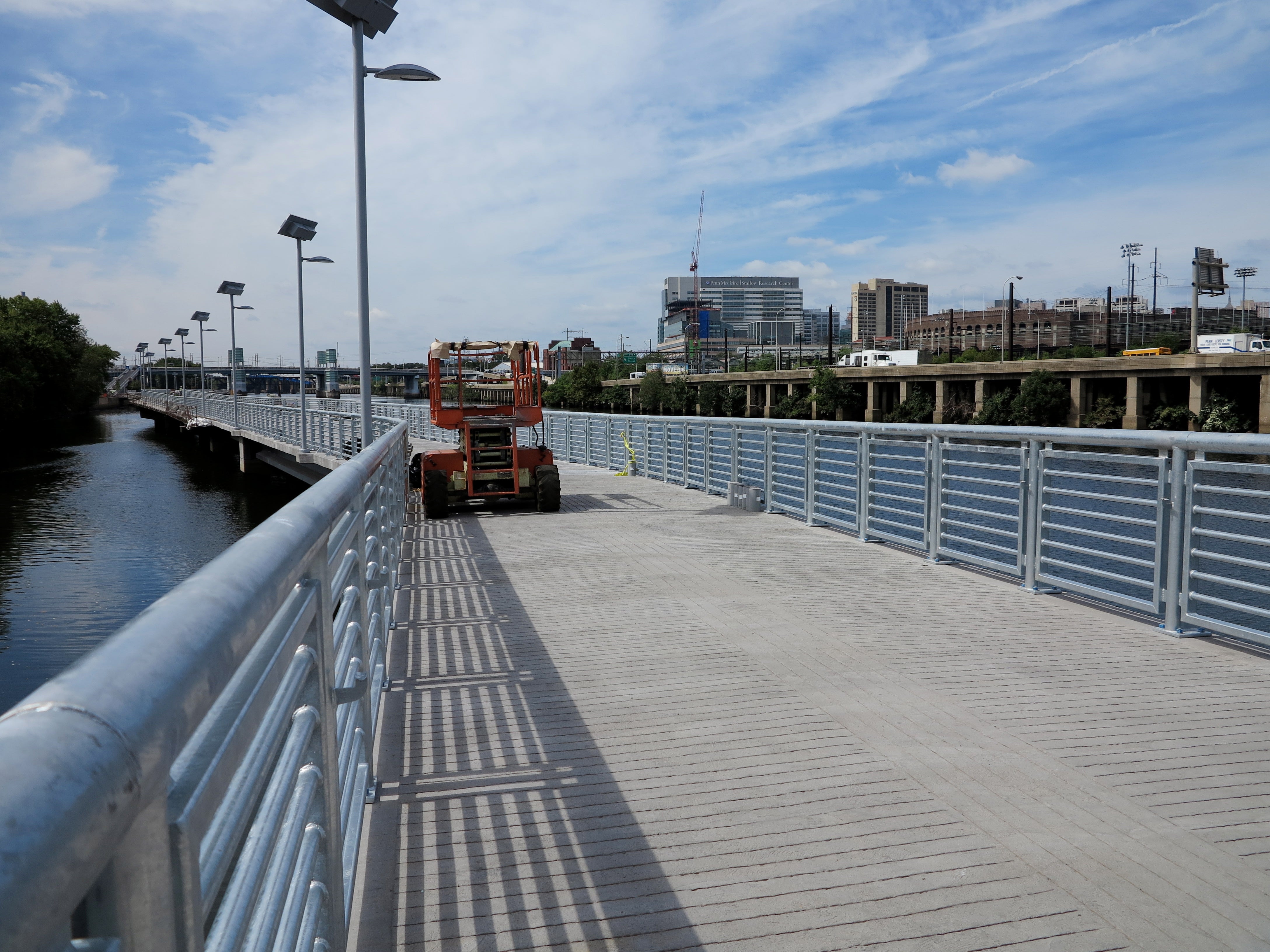Schuylkill Banks Boardwalk preview

The new Schuylkill Banks Boardwalk isn’t fancy, but it’s the sort of urban gesture that changes your view of a city. It says Philly is a place serious about investing in non-car mobility, connecting people with the river running through the heart of town, and building recreation amenities that enrich our public realm too. We build things like the boardwalk because they make city living better.
The new boardwalk extends the ever-popular Schuylkill River Trail south 2,000 feet, like a an arm bent out into the river to carry the trail from Locust to the South Street Bridge, parallel to the river’s eastern shoreline. It’s a $17 million collaborative project between the city and the Schuylkill River Development Corporation, funded through federal and state grants.
After watching boardwalk construction for the last year and a half from the South Street Bridge, I got to walk the boardwalk this week. The boardwalk is weeks from completion. As workers focus on final touches, the experience of being so close to the river is already delightful. Light and a gentle breeze played on the water. Skyline views are familiar but somehow new. The tide was coming in.
Boardwalk By the Numbers:
- Length: .41 miles
- Width: 15 feet wide
- Distance from shore: 50 feet
- Number of overlooks: 4
- Cost: about $17 million (combined federal TIGER and state funds)
The boardwalk’s design elements are sturdy and simple, meant to withstand flooding. It is primarily built of concrete and stainless steel, supported by piers drilled 20 feet down into bedrock. The railings are horizontal bands of stainless steel, a more open design than those used elsewhere on the trail in the hope that they will trap less flood debris. The concrete surface is scored with a “boardwalk” pattern – meant to look like planks and ensure that the surface isn’t slippery.
Back on May 1 the boardwalk had its first flood, submerged thanks to extreme rains the day prior. When the water receded the boardwalk was fine – some of the contractors’ tools and temporary wooden railings were not.
Though utilitarian, the boardwalk is infrastructure as public space. There’s no room for the trail to continue on land, so the boardwalk is a means for the trail to keep growing southward toward Fort Mifflin. It’s a key piece of The Circuit, our regional trail network, built with biking, running, and walking in mind. But the boardwalk also promises to be a public promenade meant for more passive activities, from fishing to people watching. The trail widens for four wide overlooks which will have benches so people can sit and take in the scenery. Plus, imagine what fireworks will look like from here on the Fourth of July.
When the boardwalk opens in about a month, Philadelphians will be able to walk on water (almost). Because of the river’s tidal variation of five or six feet and the boardwalk’s location about 50 feet from the shoreline, high tide promises to make the boardwalk feel like it’s floating on the river. Like the river, the boardwalk meanders. It’s jagged course should ensure that the boardwalk isn’t a raceway for those on wheels. These shifts also help reveal city vignettes that unfold gradually, and keep the .41-mile trip interesting.
Being able to see Center City, University City, the South Street Bridge, and the river from the boardwalk is rewarding. Looking across the water to the Schuylkill Expressway is not. Yet the boardwalk offers a study in city tempo: On the western side of the river cars speed on the expressway as Amtrak and SEPTA trains zip past in bursts. On the near side, CSX trains lumber along the tracks and on the trail cyclists and runners jostle for space with slower moving pedestrians. And then there’s the river’s tidal flow, with occasional boats. Soon the boardwalk will add its hum this busy flow.
WHYY is your source for fact-based, in-depth journalism and information. As a nonprofit organization, we rely on financial support from readers like you. Please give today.
















